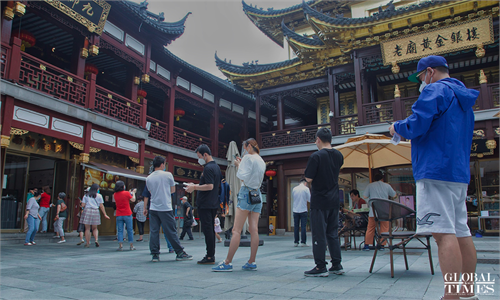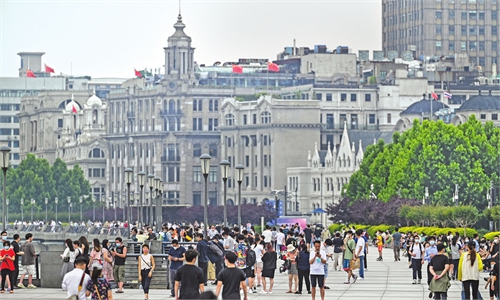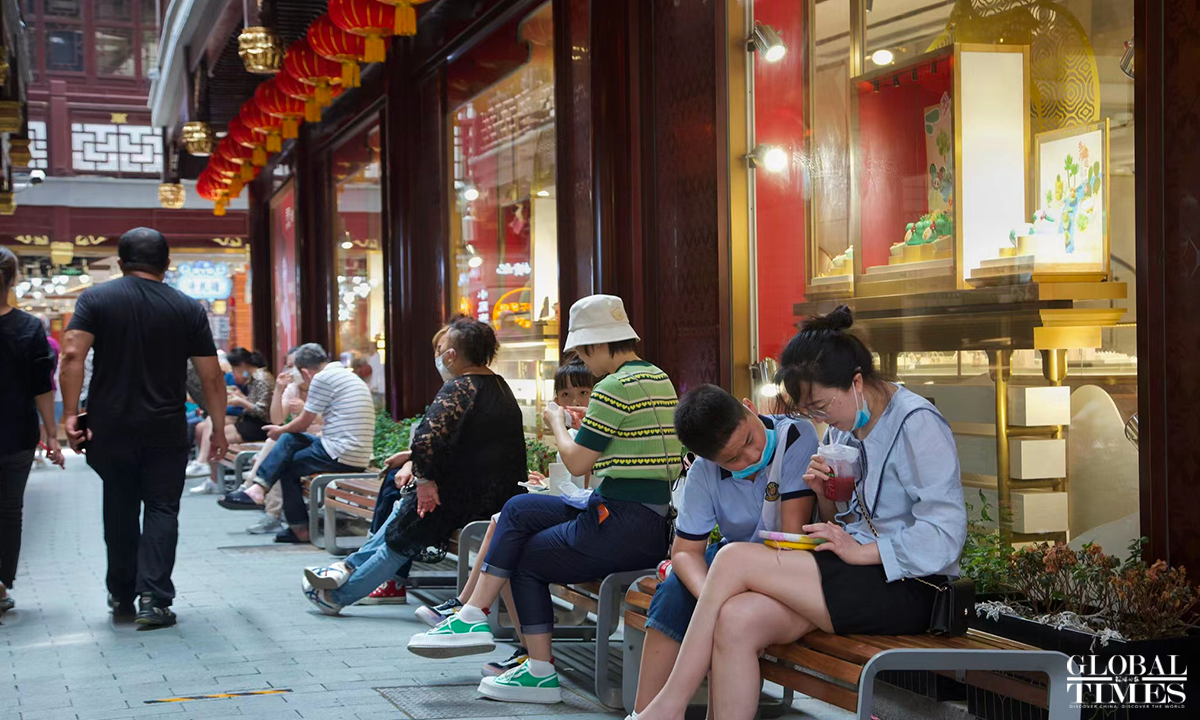
On the first day of Shanghai resuming normal life, one of the main attractions in the city, the Yuyuan Garden welcomes tourists on June 1. Visitors take photos and many time-honored brand restaurants welcome customers. At present, the scenic spot requires visitors to make an appointment and show their health code to enter. Photo: Wu Shiliu/GT
As Beijing on Sunday announced a major reopening of dine-in services, schools and scenic spots, Shanghai has embraced a fully normal life and work and Guangzhou saw a return of dragon boat racing for the first time after a two-year hiatus, China is marching toward the second half of 2022 with a hard-won victory against the stealthy Omicron variant and great hope for achieving its full-year economic growth target.
Chinese economists said Beijing's lifting of COVID-19 restrictive measures and Shanghai's resumption of normal life, which came two weeks earlier than expected, will surely lay a good foundation for a fast track economic recovery, leading to a 90 percent chance of positive economic growth for the country in June and clear positive economic growth in August.
The Beijing municipal government on Sunday announced that it would allow dine-in service in restaurants from Monday except for Fengtai district and parts of Changping district, one month after it banned the service citywide to contain the Omicron variant. Primary and middle school students will also resume offline classes from June 13.
The Global Times reporter learnt from several restaurants including hotpot chain Haidilao that they were making full and orderly preparations on Sunday for the resumption of dine-in services.
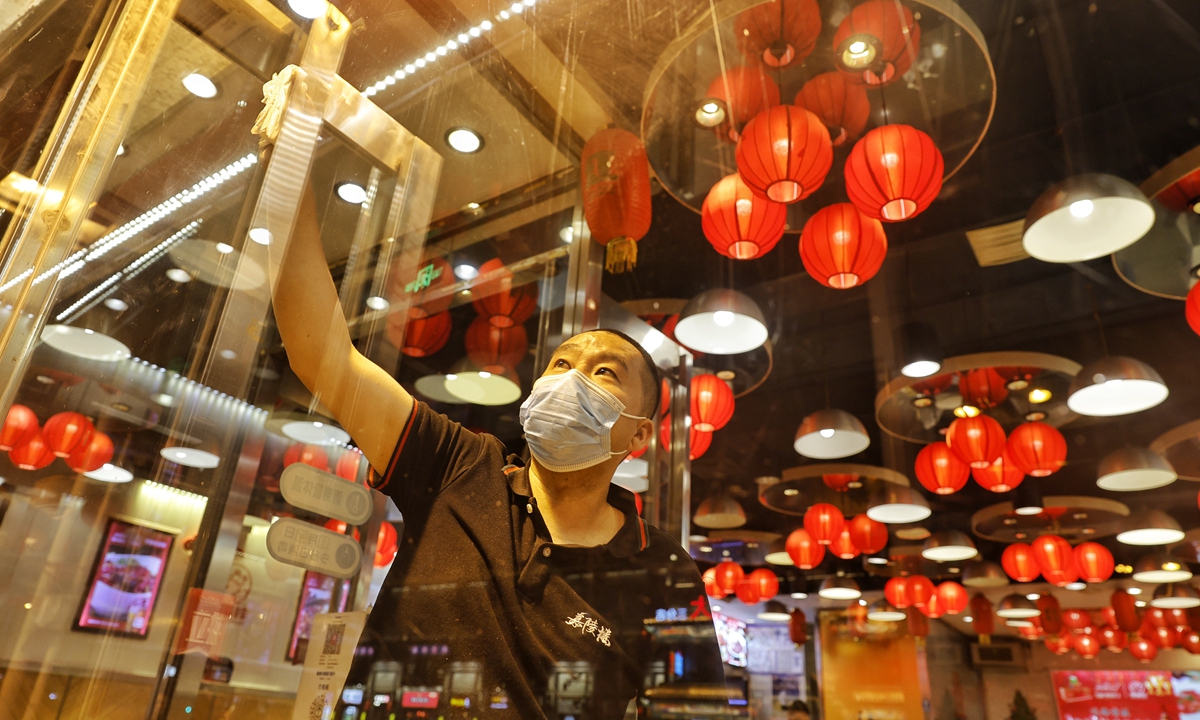
A restaurant staff member cleans a window on June 5, 2022 to prepare for the first group of dine-in customers after a hiatus of more than a month. Beijing will resume dine-in services for restaurants from June 6 after a COVID-19 resurgence was mostly curbed. Photo: Li Hao/GT
The number of daily new locally-transmitted infection cases across China has dropped to below 100 for six days in a row. China's National Health Commission on Sunday urged Shanghai to resolutely prevent the resurgence of COVID-19 and Beijing to cut off transmission chains.
A senior expert with Chinese Center for Disease Control and Prevention told the Global Times on condition of anonymity on Sunday that Beijing's lifting of major COVID-19 restrictions on Sunday demonstrated Chinese megacities' successful practice in timely and targeted epidemic measures against Omicron after Shanghai's tough and difficult battle, which saw the country's financial hub being placed under lockdown for more than two months.
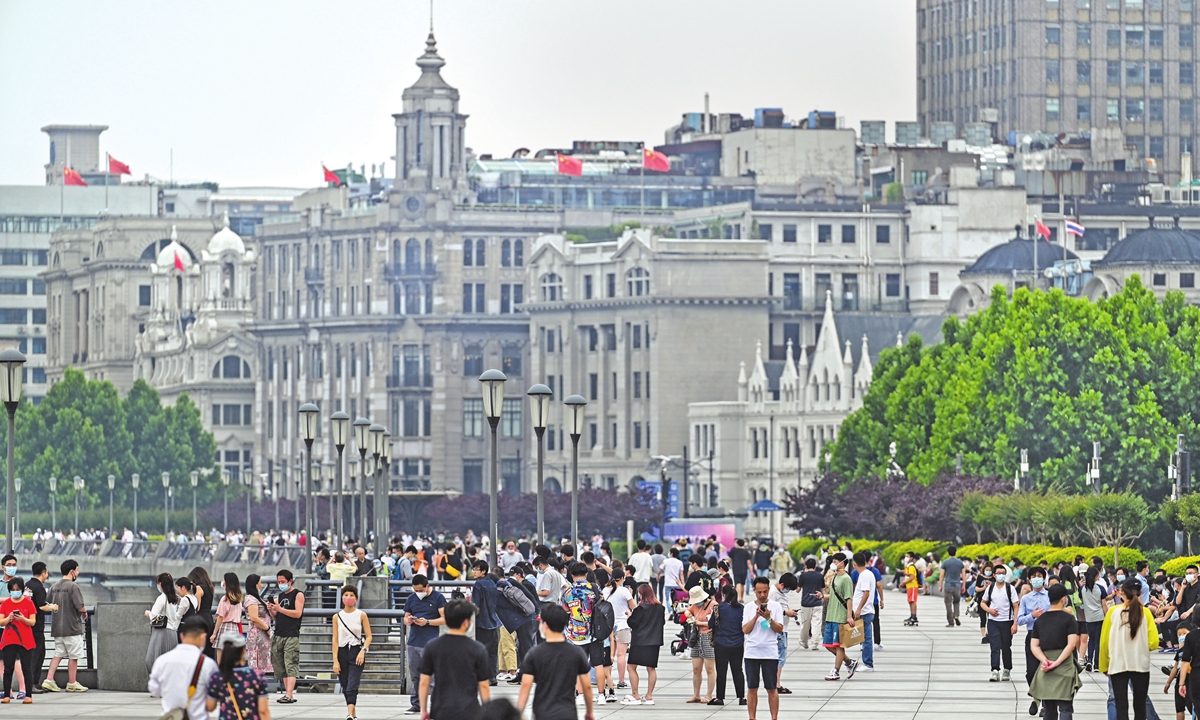
People gather on the Bund along the Huangpu River in Shanghai on June 1, 2022, following the easing of COVID-19 restrictions in the city after a two-month lockdown. Photo: AFP
While announcing that most restrictions were being lifted in the capital, Beijing government spokesperson Xu Hejian said on Sunday that stringent measures will remain in place in Fengtai district and parts of Changping district, and residents in the area have to work at home until Thursday.
The expert said Beijing's decision to reopen most parts of the city while putting two districts under stringent measures demonstrated Beijing's targeted measures under the dynamic zero policy, which was based on the early detection of the virus, and has successfully prevented the capital from being placed under citywide lockdown.
One highlight of Beijing's announcement was that it required negative nucleic acid testing result taken within 72 hours for entering public venues, and the expert believed that regular nucleic acid testing will provide a critical foundation for the reopening of COVID-19-stricken cities, as there are no other ways to detect the virus at an early stage.
Liang Wannian, head of China's COVID response expert panel under the National Health Commission, said in an earlier press conference that citywide static management or lockdown can be effectively avoided after implementing measures focused on "early detection, early reporting, early quarantine and early treatment," and setting the responsibilities of various departments.
As majority of the country enters booming season of summer in June, economic recovery is also heating up, with the recent three-day Dragon Boat Festival holidays bringing a vibrant consumer market nationwide.
Passenger journeys are also picking up, with 6.4 million passengers expected to travel by train on Sunday, according to China Railway. The national railroad carried an average of 5.4 million passengers per day from June 2 to June 5, an increase of more than 2 million over levels recorded during the May Day holidays.
Domestic tourism has also been recovering steadily during the holidays, especially in Shanghai and Beijing. Online travel agency Lvmama said to the Global Times on Sunday that the number of tourists on the first day of the Dragon Boat Festival holiday increased by about 43 percent compared with the first day of the May Day holiday, and travel fever has hit the Yangtze River Delta region with many parks in Shanghai welcoming large numbers of tourists. Tickets for the Shanghai Haichang Ocean Park were fully booked soon after Lvmama launched the trip on Friday night.
South China's Guangzhou launched its long awaited dragon boat races and exhibition activities during the holidays for the first time in two years. In 2020 and 2021, the Chinese carnival in southern China, which features teams competing on the water and spectators gathering to watch and drink, was canceled in most parts of the city due to epidemic.
Fast track recovery
The full resumption of work and production in Shanghai and the return of dine-in services in restaurants in Beijing come about two weeks earlier than expected, leading to a 90 percent chance of positive economic growth for China in June, Cao Heping, an economist from Peking University, told the Global Times on Sunday.
"China will see a clear positive growth in August. The national unified dynamic zero-COVID policy laid a solid foundation for the recovery of the entire economy," said Cao.
"If the epidemic is completely contained in the second half of this year and the impact of the Russia-Ukraine conflict is limited within the European continent, it is highly possible for China to achieve full-year economic growth of 5 percent or more," Cao noted.
Since Shanghai lifted its lockdown from June 1, all shopping centers, parks, restaurants, and KTVs have reopened to customers, with searches of hotpots, KTVs and nail salons on several online platforms increasing by 200 percent compared to last month.
During the past three days, more than 600 inbound and outbound cargo and mail flights have been cleared at Shanghai Pudong Airport, with more than 200 flights taking place per day. The volume of cargo and mail flights has approached pre-epidemic levels, China Central Television reported on Sunday.
Hu Qimu, chief researcher at the Sinosteel Economic Research Institute, told the Global Times on Sunday that China's economic recovery will be on the fast track from June, and he was optimistic that the country will realize its 2022 GDP target of around 5.5 percent.
The outbreak in the first half of the year mainly affected the Yangtze River Delta, but several other major pillars of the economy such as the Pearl River Delta, Yangtze River Economic Belt and Chengdu-Chongqing economic circle have been operating normally. Although some medium and high-end industries, such as automobiles, chips and medicine were impacted due to flare-up in Shanghai, electronic equipment manufacturing has been less affected, Hu said.
In terms of the driving forces of economic growth, Cao said that there are no problems with China's exports, as the pandemic has had a big impact on production in other countries, and Chinese products are in high demand. At the same time, China is the backbone or core link of many global supply chains.
Cao cited the Kunshan New & Hi-tech Industrial Development Zone (KSND) in East China's Jiangsu Province as an example. The KSND is home to the world's largest display manufacturing base, producing 50 percent of the world's screens for mobile phones, tablets and computers.
"The digital industrial upgrading of the manufacturing industry, which China explored during the epidemic, can precisely drive the rapid growth of new digital consumption. New consumption is exploding," said Cao.
For example, smart household appliances or intelligent household robots, involving chips, display screens, data transmission and storage, management and operation, have a very long industry chain, and will bring enormous industrial growth and consumption, he said.

